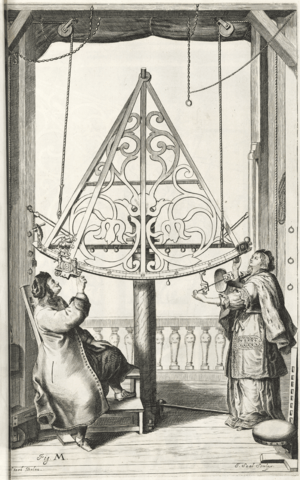Elisabeth Hevelius facts for kids
Elisabeth Catherina Koopmann-Hevelius (born January 17, 1647 – died December 22, 1693) was an amazing early female astronomer. She was born in Gdańsk, which was then called Danzig, in Poland. Elisabetha worked closely with her husband, Johannes Hevelius, to make important discoveries about the stars.
Contents
Early Life and Family
Elisabeth Koopmann came from a wealthy merchant family in Danzig, just like her husband. Her parents were Nicholas Koopman and Joanna Mennings. They were married in Amsterdam in 1633.
Her family moved from Amsterdam to Hamburg. Then, in 1636, they settled in Danzig. This city was part of Poland, but many people there spoke German. Elisabetha was born in Danzig.
Working with the Stars
Elisabetha loved astronomy from a young age. She became interested in the work of Johannes Hevelius. He was a very famous astronomer who had the best observatory in the world. His observatory was located in three houses in Danzig.
In 1663, when Elisabetha was sixteen, she married Hevelius, who was fifty-two. This marriage allowed her to follow her passion for astronomy. She helped him manage his amazing observatory.
They had a son who sadly passed away soon after birth. They also had three daughters who grew up. Their oldest daughter was named Catherina Elisabetha, after her mother.
Elisabetha got sick with smallpox, which left scars on her face. After her husband died in 1687, she finished and published their big book. It was called Prodromus astronomiae (1690). This book listed 1,564 stars and their exact positions.
Why Latin Was Important
We know that Elisabetha wrote letters to other scientists in Latin. This was the language used by scholars and scientists across Europe back then. It helped them share their discoveries.
It was very important for her to learn Latin. This skill allowed her to communicate with other smart people. It also helped her understand scientific texts of her time.
Later Life and Legacy
Elisabetha Hevelius passed away in December 1693. She was 46 years old. She was buried in the same tomb as her husband.
After her death, a mathematician named François Arago praised her. He said she was the first woman he knew who wasn't afraid to do the hard work of astronomy. This included making observations and calculations.
In Culture
Elisabetha's life was made into a historical novel in German. It was called Die Sternjägerin (The Star Huntress) and came out in 2006.
A small planet, 12625 Koopman, is named in her honor. There is also a crater on Venus called Corpman.
See also
 In Spanish: Elisabeth Hevelius para niños
In Spanish: Elisabeth Hevelius para niños




